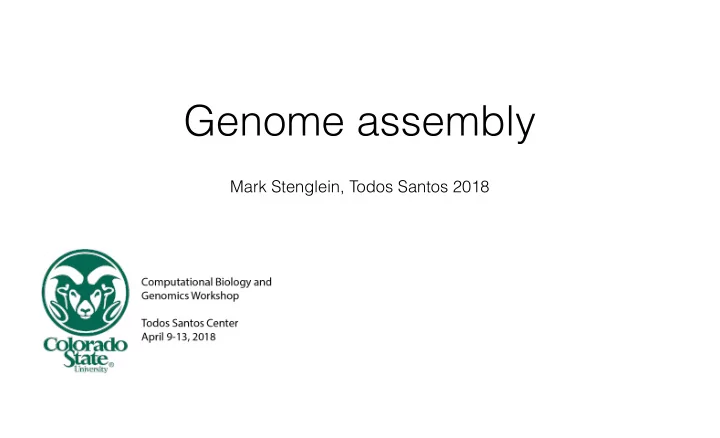

Genome assembly Mark Stenglein, Todos Santos 2018
Genome assembly is the process of attempting to reconstruct a genome sequence An assembly is only a “putative reconstruction” of the genome sequence [Miller, Koren, Sutton (2010)] Keith Bradnam, UC Davis Baker M (2012) Nat Methods
Genome assembly paper exercise Your job is to assemble the ‘genome’ from which the ‘reads’ you’ve been given derive. Rules/info : • Like real sequencing data, these reads contain errors. The error rate is ~2% • These are single-end 11-base reads • The average coverage is ~6x • You’re not allowed to google the answer • Also: the answer is in the slides: don’t cheat! • You can use your computers (i.e. word processors or text editors) or paper and whatever strategy you want to do the assembly… Exercise inspired and enabled by Titus Brown: http://ivory.idyll.org/blog/the-assembly-exercise.html
Genome assembly paper exercise “Even if they are djinns, I will get djinns that can outdjinn them.” Ngugi wa Thiong’o, Wizard of the Crow “Jinn (Arabic), also romanized as djinn … are supernatural creatures in early Arabian and later Islamic mythology and theology.” https://en.wikipedia.org/wiki/Jinn Exercise inspired and enabled by Titus Brown: http://ivory.idyll.org/blog/the-assembly-exercise.html
Conclusion: assembly is not trivial! In this exercise, the ‘genome’ was only 65 positions long, and its alphabet contained 26 ‘bases’ (more information rich) the human haploid genome is 3 Gb Eukaryotic genomes can have billions of bases and there are only 4 bases (less information) Bolzer et al (2005) PLoS Biol
Some of the main reasons that assembly is difficult Alu sequences in the human genome 1 million copies, ~10% of the mass 1) Genomes are chock full of repetitive sequences 2) Reads contain errors Bolzer et al (2005) PLoS Biol 3) Uneven coverage, including possibly no coverage for particular regions (e.g. GC-rich regions) 4) Even with fast computers, it’s still computationally difficult 5) Since you don’t know what the ‘answer’ is, it can be difficult to assess whether your assembly is ‘good’ or not 6) Polyploidy means you are effectively assembling >1 closely related, but not identical, genome 7) Not to mention annotation, which can be as hard as assembly!
De novo assembly is like doing a jigsaw puzzle without the picture on the box Images, metaphor: Keith Bradnam, UC Davis
‘Reference-guided assembly’ is a slightly different, easier problem analogous to knowing what the puzzle should generally look like Images, metaphor: Keith Bradnam, UC Davis
Reads are assembled into contigs, contigs into scaffolds, and scaffolds into chromosomes or genomes contigs scaffold Image: Keith Bradnam, UC Davis
These “contigs” could be scaffolded Image, analogy: Keith Bradnam, UC Davis
Nearly all assemblers use a de Bruijn graph-based algorithm De bruijn graphs are directed graphs with connected nodes of overlapping k-mers Generic simplified strategy: • Attempted error correction • Break reads into overlapping k-mers (here k = 4) • Construct de Bruijn graph of k- mers • Trace path through graph: Tada! Genome sequence Image: Miller, Koren, Sutton (2010) Genomics
end k=10 start Even if they are djinns, I will get djinns that can outdjinn them http://debruijn.herokuapp.com/graph
k=8 branches bubble (circular path) start Even if they are djinns, I will get djinns that can outdjinn them http://debruijn.herokuapp.com/graph
Assemblers use a variety of strategies to try to resolve graph complexity To read more about these strategies: Miller JR, Koren S, Sutton G. Assembly algorithms for nextg eneration sequencing data. Genomics 2010;95:315–27. • Compeau PE, Pevzner PA, Tesler G. How to apply de Bruijn graphs to genome assembly. Nat Biotechnol 2011;29:987–91. • Nagarajan N, Pop M. Sequence assembly demystified. Nat Rev Genet 2013;14:157–67. • Sohn JI, Nam JW. The present and future of de novo whole-genome assembly. Brief Bioinform. 2016 Oct 14. pii: bbw096. • Note that the as long read sequencing continues to improve and gain ground, these issues may become moot. Assemblies that mix long and short reads are called ‘hybrid’ assemblies, and they are increasingly the norm.
A key question: How do you know if your assembly is any good? • Size of the assembly: does it match estimates from other means? • Size of the contigs/scaffolds: are they reasonably long? • Are the expected ‘core genes’ present in the assembly? • What fraction of reads map to the assembly? • Does the assembly contain sequences of contaminating organisms? • Is the assembly consistent with independently derived data? (optical mapping, transcriptome sequencing, genomes of related organisms?) For what purpose do you need the assembly? These questions apply to assemblies in databases too.
Mini exercise Visit the pages for the 2 assemblies. Batrachochytrium dendrobatidis Which is better? cause of chytridiomycosis in amphibians a common assembly metric: N50 : a measure of the average size of image: Gewin V. (2008) PLoS Biology contigs & scaffolds
I’m painting a somewhat bleak picture, but don’t be too intimidated: genome sequencing and assembly is possible. Not all assembly problems are equally difficult! Loblloly pine ( Pinus teada ) tiny ssDNA genome bacterial genomes ~5 Mbp 22 Gbp genome! image: viralzone Nakazawa et al (2009) Genome Research image: Univ of Alabama
Reading what others have done is a great way to figure out what you could do
You could call these ‘bioinformatics protocols’ Read and synthesize a bunch of these like you would ‘wet lab’ protocols Chamala et al (2016) Science Fitak et al (2016) Mol Ecol Resources
Bioinformatics protocols are analogous to any lab protocol Fitak et al (2016) Mol Ecol Resources
Questions? Image: Keith Bradnam, UC Davis
Recommend
More recommend